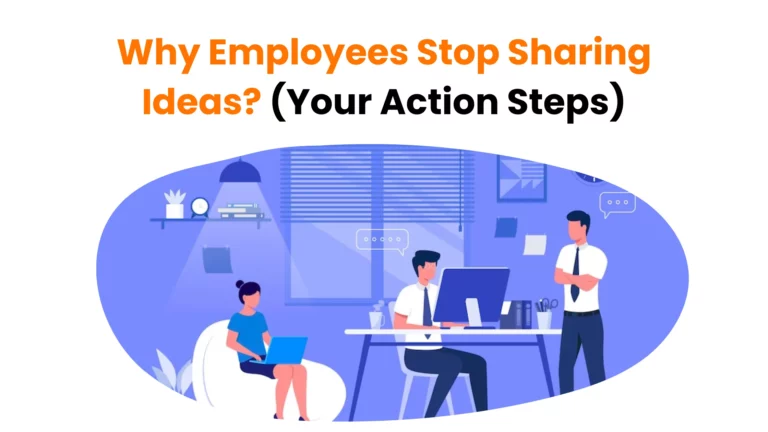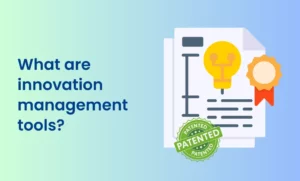We’ve all been team members before becoming a leader or a manager. The fear of embarrassment, lack of confidence, and apprehension about getting your ideas rejected (that too in front of everyone!) is too real.
And when such emotions aren’t regulated well by the leaders, they become a part of an employee’s work personality.
But that’s too much of a simplification.
There are employees who are super talented but slack off.
Some employees want to share ideas but have no clue what, why, where, and how.
Then, there are managers who receive amazing ideas but don’t know how to deal with them.
Even the biggest and greatest companies become a breeding ground for stagnation, begging the ultimate question of why employees stop sharing ideas.
And since one employee’s disinterest results in a domino effect that derails the company’s motivation, productivity, and efficiency to its core, we need to find out why employees stop sharing ideas.
Why employees do not share knowledge?
#1 You’ve made it difficult to share ideas
In one of our UX improvement surveys, we asked employees of our clients about the one blocker they had for sharing ideas before their onboarding to Idea Assist. Almost 85% of the participants mentioned that earlier:
- They did not know whom to approach.
- If they knew, they found it difficult to directly approach a leader for fear of disturbing them or getting no response.
- Their ideas were lost in emails.
Basically, even if an individual has an idea, there’s no clear guidance and medium to share and capture it.
Solution: Make It Simple
Employees always feel apprehensive about disturbing their leads and sharing their thoughts. Then there’s the fear of both ticking off management and losing their job. They often end up talking themselves out of putting their ideas out there.
So, if you expect your employees to come out of their shells, visualize solutions, carve time from their key tasks to share their vision, you better make idea sharing in the workplace frictionless. Make the capturing ideas process easy!
#2 Your employees already have a lot on their plate
Let’s understand this through an example.
As a content strategist, one is expected to work on at least ten tasks, ranging from medium to high priority levels.
If, on top of that, the top management decides to make innovation a key responsibility area on which they’d be evaluated and appraised, what would happen?
Some adjustments, a brief period of trying to make the cut, and eventually, churn. At the same time, they would always feel the burden of getting fired for not coming up with novel ideas.
It’s not that the person is not a good employee. Most probably, they are excellent at their designated role, but choosing between their tasks and innovating might cause a disbalance on a daily basis. As a consequence, total chaos, no employee engagement, and no team engagement.
Solution: Make Innovation Fun, not a Mandatory Task
Firstly, do not turn sharing ideas into a task and cultivate the feeling of safety.
As Instagram Gurus say, “The more you let go, the more you receive.” It’s true!
When you give your employees a breathing space and a safe space to contribute at their will, your workplace culture thrives. Innovation becomes a part of your organizational culture and is not considered a separate task.
For example, within a month of using Idea Assist by InspireIP, an idea sharing platform, our clients see an instant uptick in the number of employee ideas. Especially, from the different verticals within the company using our Innovation Challenges feature.
IP Assist by InspireIP turned adding invention drafts and disclosure into a fun task. Thus, companies saw an uprise in the number of disclosures filed and then pursued.
Ultimately, you need to dive deep into what drives human behavior in the workplace and change your employee idea program and innovation program accordingly.
But we can say one thing from experience: Encourage staff to add ideas from anywhere and at any time through their phone, tablet, or laptop. You foster a positive work environment.
#3 Silos are ruining it for everybody
We are pretty sure that if you asked individuals from your organization to tell you about your company’s resources, programs, and processes dedicated to innovation, their answers would differ.
Silos often become the reason for process constraints. Eventually, they make it impossible for organizations to infuse innovation as their second nature.
For example, here are the scenarios occurring due to deeply entrenched silos leading to why employees stop sharing ideas:
- The organizational hierarchy made it impossible to understand which person would be the best choice for sharing a particular idea.
- Employees are forced to wait to communicate their idea. Hence, they lose interest or zeal. Engaging employees requires workforce engagement.
- Their idea got lost in the email threads. Or, it was picked, but the email threads made it impossible to keep track of everything.
- There were too many referrals and redirects before the idea actually reached the right person.
Solution: A Decentralized Idea and Innovation Management Software
The need of the hour is to have an AI-powered, cloud-based, and multi-device compatible tool that does all the work for you.
Idea management and engagement in the workplace should be your highest priority to ensure employees never feel dejected. And a professional tool ensures that the right team receives the right idea, enabling swift implementation and recognition of employee contributions.
But do not forget the growing CIO’s role in innovation. Leadership and a dedicated software place you several steps ahead of your competition right away.
#4 Your employees never heard back from you
66% of employee ideas are lost, and organizations fail to capture innovation.
Can we even blame employees when they stop sharing their ideas?
The most understated fact is that top management ends up reflecting toxic leadership where they only ask employees to think outside the box to make their company better. Because when they do, they either get defensive or simply dismiss their efforts by not responding appropriately and at the relevant time.
You’d be surprised to know that most of the surveys out there prove that the common response to an individual going to their manager and sharing their thoughts is:
- Silence. They never hear back from their manager about the idea they shared. So, without any positive or negative feedback, there is no motivation to keep going.
- This is not your area or department. Please focus on your KRAs.
In the end, employees, afraid of retribution, refrain from sharing a solution that could have improved internal processes and generated revenue.
Solution: Status Visibility and Transparency
You MUST introduce a structured, formalized, and decentralized communication process for the entire ideation process–from idea inception conceptualization to implementation.
Here’s a knowledge nugget for you: InspireIP enables systematic and timeline-based tracking of each idea till its implementation. There is complete idea visibility.
Coming back to the point, there should be transparency and accountability for each idea captured to ensure no idea is left unchecked.
An employee should never have to wonder what happened to their idea. The evaluation and analysis team should be held accountable.
Since an automated system does all this for you, you can just sit back and check the progress of your innovation pipeline.
#5 They are not sure why they should share ideas
Another truth bomb: everyone is selfish.
Everyone wants to know the benefit of them going above and beyond for you.
So, let me ask you. Have you made a strong case for sharing ideas and making innovation a part of their work?
Don’t confuse top talents’ desire to innovate with them actually putting in effort for your organization.
Their will to practice autonomy over their work doesn’t mean they will do it for you. You need to first establish an intrapreneurship culture within your organization to actually see productive results.
But don’t just establish a few processes; follow through!
Also, let’s now forget that there will be employees who might have just started in your company or might be freshers who need guidance and motivation to not keep to themselves.
Solution: Communicate and Articulate
As a leader of your team or your company, it’s your responsibility to communicate regularly and profusely why employees need to proactively share ideas, participate in innovation challenges, and practice intrapreneurial activities.
You also need to illustrate the benefits and rewards of being an innovator and discuss how failures do not mean punishments or setbacks.
Creating a culture of open critique communications, where everyone wants to be challenged constantly, is the only way to business innovation.
#6 You follow a top-to-bottom approach
When you ask for solutions, do you ask everyone at once, or does the top management or middle management take a go at it first, and then comes everyone?
For example, if you needed ideas to use AI-powered tools in the market today, would you ask the managers first, followed by looping in their team members? Will the conversation start with the leaders providing their input and then asking the employees to share their ideas?
What do you expect the output of such a discussion or conversation to be?
It’s human nature to affirm whatever the boss or our leader says and not contest it. You have immediately turned off that novel idea button in everyone’s mind.
Why do you expect your top talent to push back and come up with novelty when you can just start from the bottom and simplify it for them?
Solution: Understand the Difference Between Leading and Managing
Big changes only happen with all hands in. There’s no second thoughts to it. Since companies have to be smart and swift, cohesion (not only cooperation) and cognizance is the way to do it.
When your employees are the first to hear about a business challenge–big or small–and are allowed to spread their wings, you see business innovation left, right, and center.
And if you have an idea management system in place to capture innovation when it happens, you’re on top of your innovation game.

#7 Your appraisal system might be turning into an obstacle
Is your feedback mechanism designed to reward individuality and only success?
Think about it for a moment.
Are there employees who showcase their expertise only when you ask them explicitly or when they receive a promotion/bonus /reward in return?
It’s not their fault or yours.
According to a study by OfficeTeam, 29% of employees said that they’ve had their ideas stolen at work.
Naturally, everyone wants to secure their ideas and get the due recognition for their efforts. When companies fail to reward and recognize the top talent and treat it as an obvious task, it becomes the topmost reason why employees stop sharing ideas.
The more you go into the corporate culture, the more you will understand the gradual shift in employee behavior.
Giving their 100% to their set KRAs. Finding time to go above and beyond. Not getting the acknowledgment if they fail to complete a set task because they were trying something new. Feeling that everyone is riding on their efforts. It messes up their personal goals.
This is where you find the gap between employee goals and business goals widening.
Then there’s the fear of failure because it affects their performance and their perception among peers.
Solution: Embrace the Failures are a Part of Success Philosophy
Here’s a checklist for you to abide by:
- Timestamp and proof of ownership of every idea submitted
- Immediate recognition and acknowledgement
- Rewards (of various statuses) to everyone who made an effort
- Communicate clearly that trying matters above anything
- Failure means lessons learned, and it shouldn’t affect an employee’s position
In a Nutshell
Why people don’t share ideas is because:
- They have no clue how to do so.
- Your idea and innovation management process is not clear and effective.
- Communication isn’t your strongest suit yet.
- Process-related obstacles are hindering the flow of ideation.
- Employees are burnt out to focus on thinking outside the box.
- You have no innovation pipeline and workflow in place to capture, evaluate, analyze, and implement ideas swiftly yet effectively.
- Toxic leadership may be around the corner.
- Your appraisal mechanism is outdated and doesn’t facilitate an innovation culture.
- Your employee engagement strategy is subpar.



